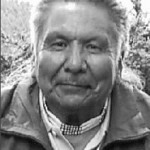 William Edward “Sonny” Sam was born May 22, 1937 in Tulalip, WA and continued his journey to be with the ancestors on September 21, 2012.
William Edward “Sonny” Sam was born May 22, 1937 in Tulalip, WA and continued his journey to be with the ancestors on September 21, 2012.
Sonny, a Tulalip Tribal Member and Bible Shaker, spent his life in this area holding jobs in logging, construction and security and always enjoyed the time he could get taking rides in the mountains, berry picking, hunting and gambling.
He was preceded in death by his father, Edward Hagen Sam; mother, Gertrude Kitsap Sam; sons, William E. Sam Jr., Anthony Kitsap Sam; daughters, Angela Sam and Loreen Sam-Barr.
He leaves behind sister, Mildred Sam-Lewis; sons, Clinton “Bodie” Sam (Tulalip), Stacey Sam (Auburn, WA); daughters, Wanda “George” Sam (Tulalip), Augusta “Gus” Lobehan (Tulalip), Jessica Myers (Tulalip); and niece, Patricia Ann Sam; 29 grandchildren; 31 great-grand-children; and many dear friends and relatives.
Sonny will be greatly missed by all whose lives were touched with his presence and prayers.
A visitation will be held on Wednesday, September 26, 2012 starting at 1:00 p.m. at Schaeffer-Shipman Funeral Home; followed by a wake service starting at 6:00 p.m. at the Tulalip Tribal Center; a Funeral
Service will be held on Thursday, September 27, 2012 starting at 10:00 a.m. at the Tulalip Tribal Center; Burial to follow at Mission Beach Cemetery, Tulalip, WA.







